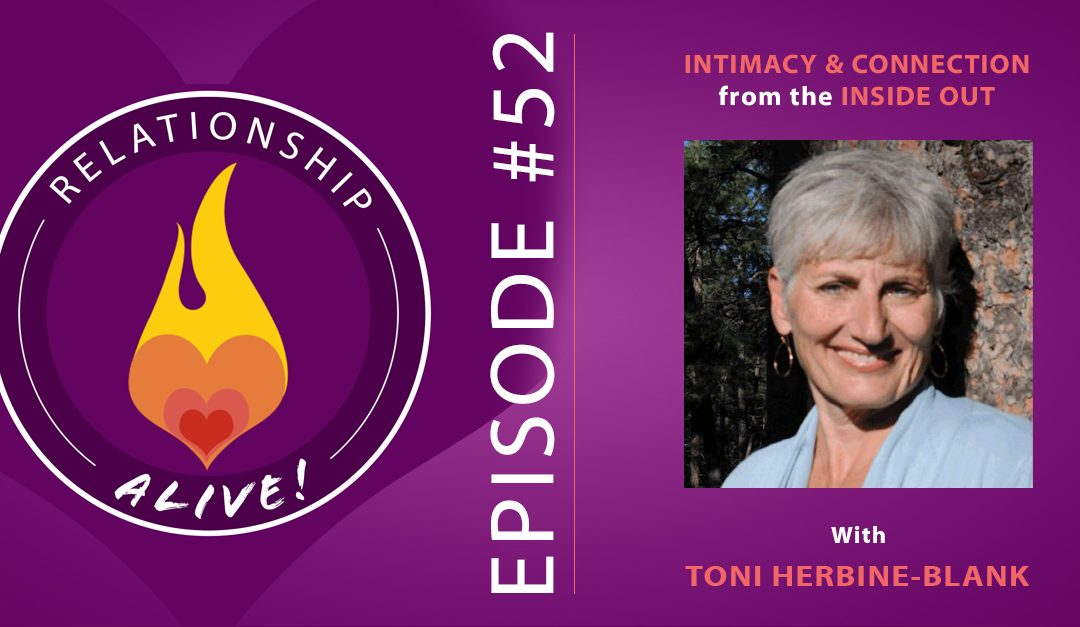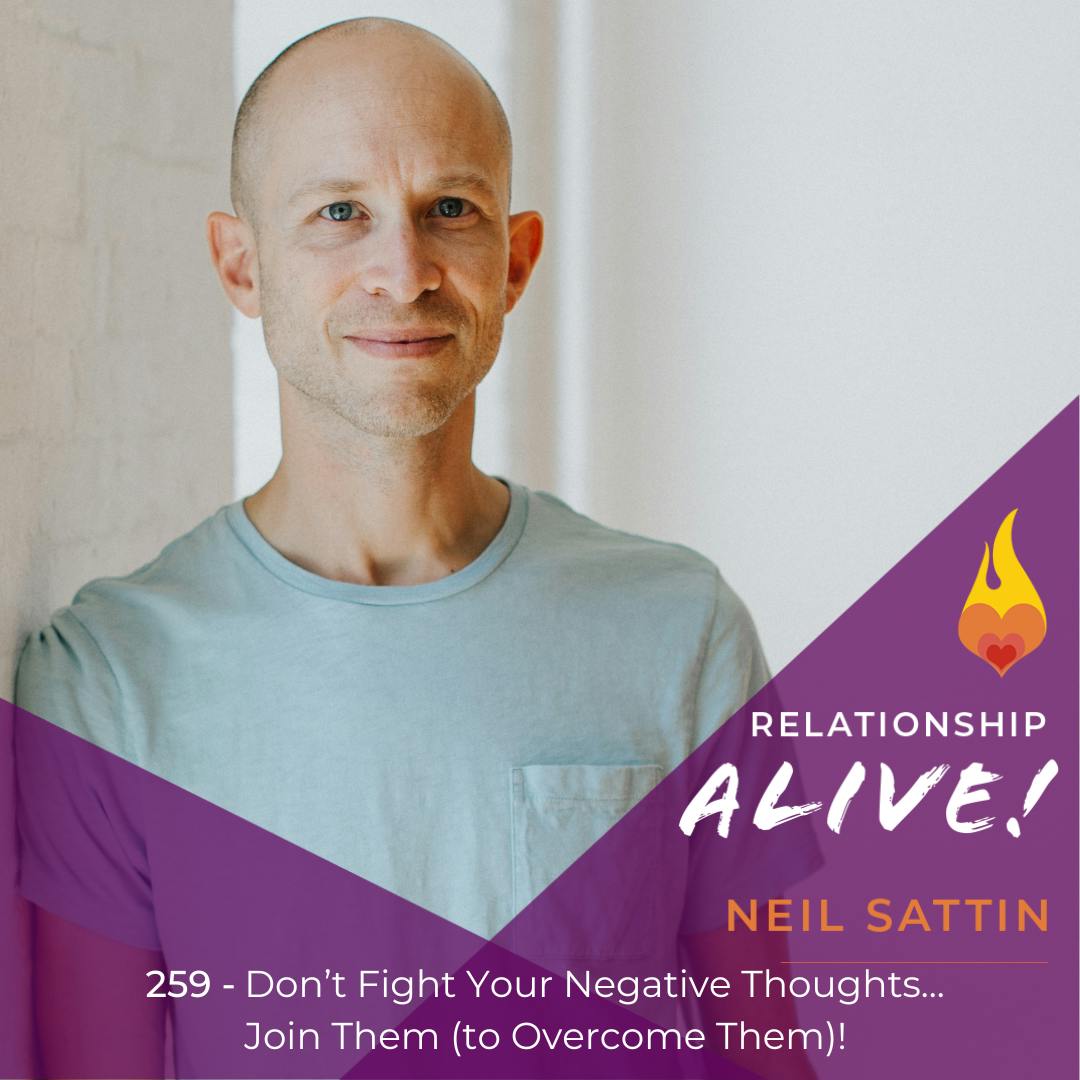How does your relationship within yourself help you develop a deeper connection with your partner? How can you balance the skills of inner work with the skills required for a thriving relationship? By now you’re aware that there are all of these parts within us that shape who we are - both how we see ourselves, and how the world sees us. You have these parts, and your partner has these parts. The more that you and your partner can be the “leader” of your parts, and the more you can interact with each other from that place, the deeper your intimacy will become. Today’s guest, Toni Herbine-Blank, has created a practical way for you to do just that. She is the developer of Intimacy from the Inside Out (IFIO) - which combines the wisdom of Internal Family Systems with Attachment Theory and state of the art couples therapy - to help you and your partner deepen your connection while making it more resilient.
Internal Family Systems Recap: For an in depth discussion on the Internal Family Systems model, revisit episode #26 with IFS founder Dick Schwartz. Briefly, IFS outlines that we each contain a Self and many many parts. We have protective parts of our personality (managers and firefighters) which have developed to take on the role of protecting the more vulnerable parts of us (exiles). Exiles are often young parts of ourselves that have been wounded in relationship and have been pushed back and tucked away by the system in order to not get hurt again. Imagine a giant umbrella with two little feet sticking out from underneath. The umbrella is the protective system (sometimes called coping mechanisms, or defenses) covering up the little exiled ones from any harm.
We do not get out of childhood without getting hurt. Whether you have experienced BIG T Traumas, or little t traumas, you, and everyone, have healing to do. We have all been wounded, even those with ideal childhoods, and our systems have responded by creating protective mechanisms. Children are brilliant at creating the defensive strategies- and now these ways of being are so tightly woven with who we think we are, and how we operate in relationship that they can go undetected.
Why think in parts? Seeing ourselves through a parts lens begins to open us up to connection, awareness, and experience of core Self. Self is unwounded, ever-present, and an incredible healing resource. It is our heart space. Without parts languaging, we can get stuck between the protective system and the vulnerabilities, leading to internal and external tension, stagnation, and cycling in ourselves and our relationships. Access to Self brings energy to a relationship from the inside out. A parts perspective also allows for differentiation between what you do and why you do it. As you learn more about your own internal system, you can begin to take responsibility for how you are showing up in your relationship without getting stuck in the shame and blame cycle that so often takes the energy and intimacy out of relationships.
The You-Turn- The You-turn is at the heart of the Internal Family Systems model, and at the core of what develops vibrant intimate relationships. As so many of us know, it is so easy to focus on our partner when we are suffering. We blame them for what they are or are not doing, and hold onto it as though it is the cause of our hurt/grief/disconnection/discomfort. The You-turn is just this- it is a redirection of focus to the internal. Invite yourself to start looking inward with curiosity- what happens inside of you in response and reaction to your partner?
Track internal cycles and sequences: By bringing curiosity towards the internal experience, we can begin to observe the unfolding of our interactions. Noticing in real-time what is happening internally slows us down enough to allow for many more options of interacting! To start learning to do this, begin by simply tracking what IS happening. Are you yelling? Withdrawing? Shutting down? Then begin to see these reactions as coming from parts of you. Bring in curiosity- what are these parts trying to protect? Developing this inner awareness takes practice, safety, and often benefits from the support of a therapist.
Listening for needs: Many couples lose connection due to communication struggles. How are you using language? What kind of language are you using? Notice your patterns in speaking and in listening. How deeply are you listening to your partner? And what is getting in the way of really being able to listen carefully? As you ask these questions, begin to invite yourself to listen deeper, meaning listening for the underbelly of the conversation. Often the content is a variation on the theme of needs. Listen under the surface of what is being said for what needs you, or your partner, are expressing a desire for being met.
Protection evokes protection: Often our conflicts arise from a protector to protector interaction. If you respond to your partner through speaking from a protective part, this causes your partner to react from their protective system, and vice versa. This quickly escalates until both of you are in full defense mode and no connection can be made until safety is reestablished. Using an IFS perspective allows you to see the defensive reactions as a sign that there is a more vulnerable voice trying to be known and heard. There is almost always much more going on in a conflict than the content- in fact, most couples generally have one fight they repeat continuously just with different ‘issues’. Thus, it is not about changing the content but rather about changing your approach to the content/your relationship to the process. You will build intimacy from the inside out as individually and together you are able to explore and understand your internal systems.
Choice equals empowerment. The more protective we are, the less we get what we want from relationship. When we are being led by our protective system our options for behavior become limited to either attacking or collapsing. This plays out in all sorts of unhealthy relationship dynamics- causing fighting, distancing, and tension. When we get triggered and hurt we are no longer clear, and when we are no longer clear we no longer have the space inside to make a decision about how we want to respond. Intimacy from the inside out helps us differentiate on the inside, which helps us expand into much more choice! As we allow more room for Self, and begin to address the underlying fears and vulnerabilities causing such defensive and protective measures, we find that we are able to be more confident, calm, creative, curious, and compassionate in our interactions. We find humor, freedom, playfulness, and new possibilities for how to navigate getting our needs met.
I have a huge heart! As much as intimacy from the inside out is about building a relationship with our vulnerable parts, it is also about reconnecting to Self. Think of Self as this beating heart that sustains life- always there pumping away in the background. Connect with the knowing that you are more than just your parts- you have a HUGE heart that you can access at any point.
How to make a YOU-turn:
- Conscious awareness- The first, and often hardest part of making a you-turn is the actual turning towards yourself, instead of the habitual focus on the other. So, with curiosity, turn towards yourself and first name that you are having a reaction/getting triggered. Begin to notice what is happening on the inside by recognizing what is happening in your body (the body is ALWAYS reacting some way or another). Is your stomach clenched? Feeling of anger in your chest? Do you want to run away? Flushed cheeks?
- Say Hi- Once you have turned towards yourself, begin a relationship with the parts of you that are showing up. Name them, start separating and differentiating from them. Differentiating and unblending from our parts- possible through naming them and asking them to give some space, is helpful in regulating affect and de-escalating ourselves. When you recognize a part, find a way to say “Hi! I get what you are up to, and I am going to help you”. When parts sense our presence (and feel Self energy) they begin to relax and once a relationship is established between Self and a part we can get to understand it and find it’s purpose and impulse.
- Ask the question- Ask your part ‘what are you afraid would happen if you didn’t do the impulse right now? If you didn’t get angry/attack/withdraw/shutdown?’ If the part trusts you are coming from a place of curiosity and not from a judgmental shame/blame part, then you will begin to hear all kinds of ways that your parts are protecting deeper vulnerabilities.
- Develop a relationship with the vulnerability. Find ways to be with your vulnerabilities gently and with compassion. Maybe you do this with the help of a therapist, a meditation practice, a support group, a friend, a walk alone, or a creative process. Be with your exiles and let them feel Self energy holding them.
- Speak for the deeper vulnerability to your partner. When you are ready, share your exiles with your partner. Teach them about what you are learning about your system.
Sharing your vulnerable parts with your partner: Know that learning to unwrap protective layers and expose vulnerability, although so crucial for intimacy, is a process that will develop slowly. This requires a level of safety and trust that many couples have long lost. That said, be patient with yourself and your partner, while knowing too that it is incredibly worth learning to do! In fact, there will be a lot of relief for your partner as they come to learn how much of your current reactions are originating in a history that came long before them. As you share how your needs are connected to childhood wounds and past hurts, their heart will soften and they will open to you with much more curiosity and compassion. This is true because as you take responsibility for your internal system, they no longer have to defend and protect themselves due to you entirely blaming THEM for your reaction, nor do they have to feel like they are the sole cause of your suffering.
Speak for parts, not from parts: Learning to speak and listen well is a courageous act for all couples. Courageous communication begins with that pause and you-turn. Take those 10 deep breaths, name to yourself what is happening, and then speak FOR your parts, rather than from them. For example, speaking from an angry part would sound like “You aren’t listening to me!”, however speaking for this angry part could sound like “There is a part of me that is really longing to be heard”. Often our parts are just trying to get our core needs met: being heard, being seen, being known, being understood, and being loved. As you begin to unearth the deeper needs and share these with your partner, you begin to engage their curious Self. Parts led interactions are often dysregulated and does not give the space or safety necessary for our partner to understand you. Speaking for your parts, especially for you exiles, invites them in for understanding and intimacy. Furthermore, ask for permission from your partner, such as “I am noticing a part of me that is getting really frustrated and I am wondering if you are available to listen?” This gives your partner permission to check in with their own parts to see if they are open and available for deeper listening.
A temporary moment of maturity (TMM): If either of you realizes that you are having a difficult time unblending from a part, and are continuing to speak FROM parts instead of on behalf of them, someone in the couple has to have a TMM and be willing to step out of the protector-protector dialogue and ask to pause and return to the conversation when you are both more available/Self led. This can be very hard to do because it is hard to truly hear your partner when you are hurt and it is even harder to put your own stuff to the side to be present. Try to simultaneously unblend from desperate parts (those pesky parts that want to fight and want the last word), while bringing your heart forward. Ultimately courageous communication is about how you hold onto yourself even when your partner is unavailable.
Experiment: Next time you feel badly about yourself or something in your life try to make a you-turn and notice just how quickly a part of you tries to find someone or something outside of yourself to blame for it. We all have such strong impulses to focus outward when we are having intense and uncomfortable internal feelings!
Shaming and blaming: Once you catch yourself pointing the finger outward, pause, take a breath and choose to go inside. Breath and ask yourself: can I just feel into what is happening in here? Remember that if there is a protective impulse, then there is inevitably something more vulnerable going on under the surface. Actually, when you feel a protective impulse coming up, it is time to get excited as this means that you have an opportunity to find out what you really need in that moment and you will then be much closer to getting those needs met! Ask your blaming/shaming parts to step to the side, and check for what that more vulnerable feeling underneath is. A great you-turn question sounds like ‘What am I feeling right now and what am I needing?’ then, ‘can I do this for myself or do I need to go outside and ask for help?’.
Inner critic: Shame is often present in us, though very hidden and well-protected. Many of us were shamed in childhood- whether it was overt and explicit messages from parents or implicit ones from school, family, or friends. When a child is shamed over and over again and there is no repair (apology or acknowledgement) they will develop a part that takes on the role of further shaming- what we often refer to as the inner critic. We quickly learn how to internalized the critical voice by developing chronic negative self talk. The ‘logic’ behind this is that this part believes that if it does a good enough job of criticizing us, we will be motivated to do/be better. Thus the inner critic’s good intention is to hopefully improve oneself. Unfortunately it does not work out that well. Not only do we deflate and exhaust ourselves, we also strain our external relationships. This is true because if there is an internal critic, then there is an external one as well. The external critic parts shame and blame those around us, as a way of trying to do to others what we are doing to ourselves in hopes of alleviating the internal dilemma. No one however, has punished or shamed their way into getting the love they want and need.
Internal attachment. The more you know how to show up for yourself in hard moments the more fully you are going to show up in your relationship! Bring your awareness to both the external and internal critics- The more you can love yourself, honor yourself, and extend compassion internally, the easier it is going to be to do that externally. As you heal the vulnerabilities that the critic is trying so desperately to protect, the negative self talk will quiet, and consequently the external critic will soften.
How big can your heart get? What is your vision? What do you want to create? Intimacy from the inside out creates reverberations felt throughout your entire relationship. Once you and your partner build a relationship with your own internal systems and learn to caretake your own parts (the protective ones and the vulnerable ones), you will move out of protector to protector driven relationship into a Self to Self relationship that is full of creativity, compassion, curiosity, clarity, calmness, and loads of intimacy. Share this heart space together and explore what it is that you want to create together. Build a shared vision. Ask yourselves what is getting in the way of expressing the fullness of your relationship potential. What is holding you back? How expanded can you get? Let your WE expand and strengthen- what a powerful force it is in the universe!
Resources
Read Intimacy from the Inside Out: Courage and Compassion in Couple Therapy
Find more information and Toni’s trainings on her website
Check out the Center for Self Leadership for Internal Family Systems trainings
https://www.neilsattin.com/toni Visit to download the show guide, or text “PASSION” to 33444 and follow the instructions to download the show guide to this episode with Toni Herbine-Blank.
Our Relationship Alive Community on Facebook
Amazing intro/outro music graciously provided courtesy of:
The Railsplitters - Check them Out!


